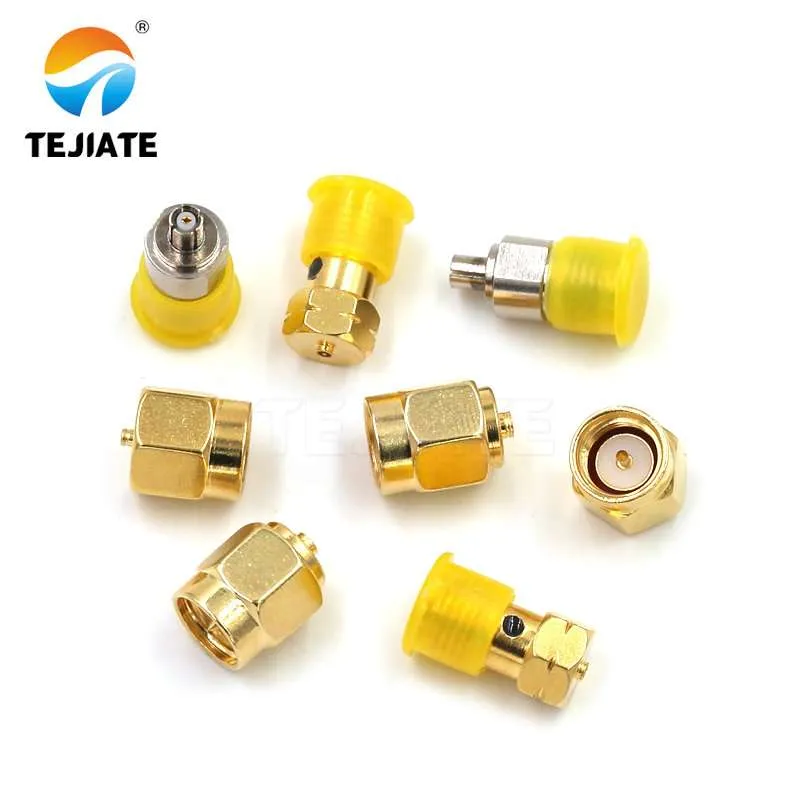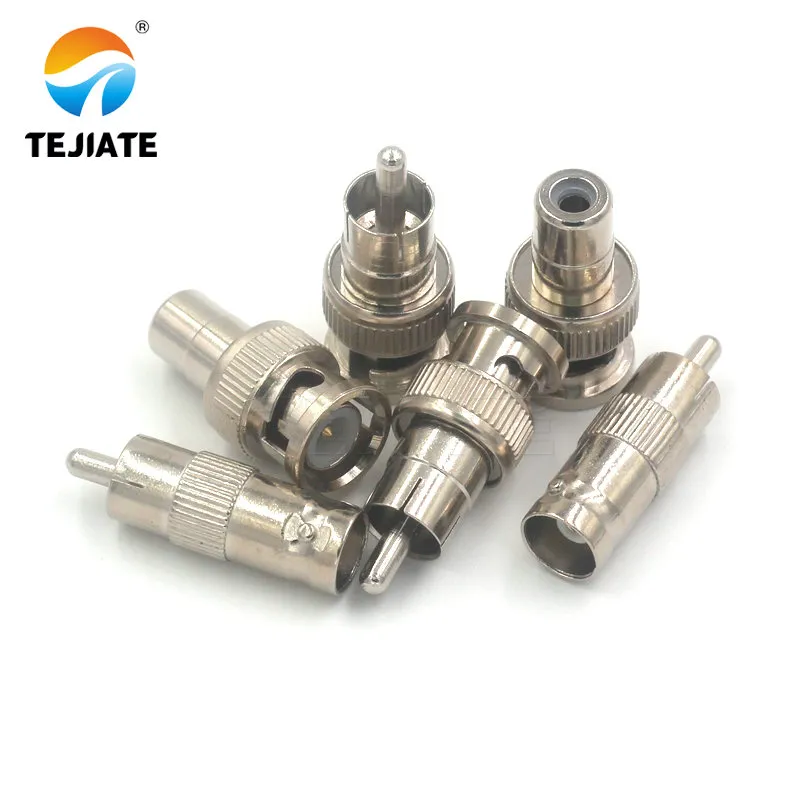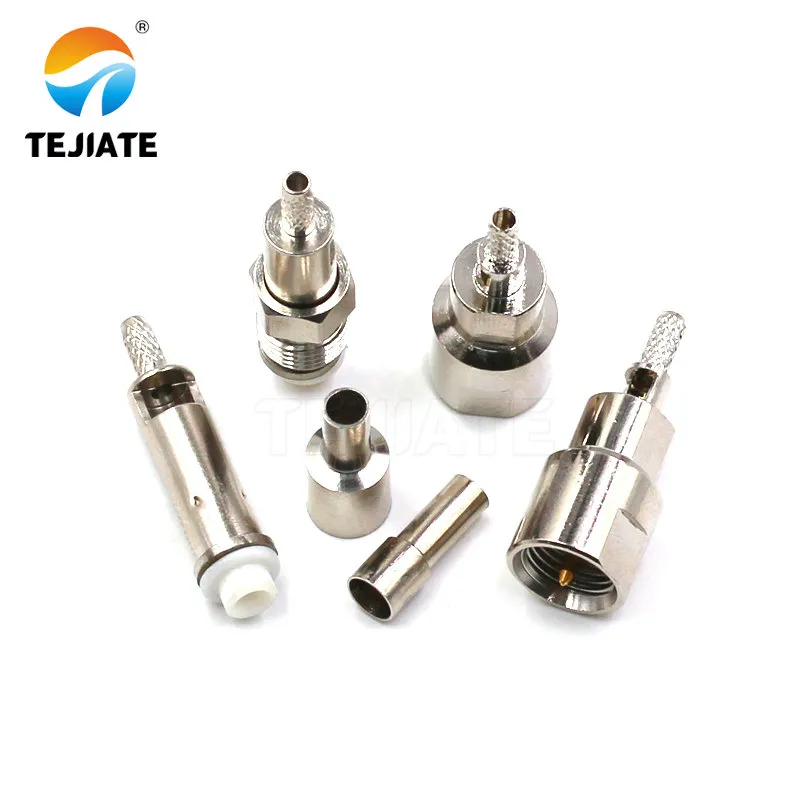How to Build a Custom RF Connector Supply Chain
July 17,2025

As 5G, IoT, and emerging networks evolve, engineers need specialized connectors for new frequency bands and harsh environments. Building a reliable custom RF connector production line requires careful planning—from identifying your niche to legal compliance and logistics. The global RF connector market size is estimated to be $15.0 billion in 2026, with an annual growth rate of approximately 6.8% . This guide will walk you through each step: defining product goals, researching the RF market, sourcing materials, selecting manufacturers, planning inventory, ensuring compliance, developing a brand/content strategy, and finally launching and iterating your product. By the end, you’ll understand how to create a strong custom RF connector supply chain for the U.S. and global communications markets.
1. Introduction
The right custom connector can make or break an RF project. An improperly selected connector can result in signal loss or regulatory challenges, while a well-designed connector ensures reliable connectivity for 5G base stations, satellite systems, IoT devices, and more. Many technology leaders (such as Amphenol, Tyco Electronics, Pasternack) are competing in this space, so custom products must clearly fit their niche. In this article, we outline the supply chain process for RF connectors : from product definition to product launch. Each of the following sections will explain how to define your RF niche, analyze the RF communications market, source components, vet manufacturers, handle logistics, meet regulatory requirements, build your brand with technical content, and iterate after the product is launched. Our goal is to help makers and companies in the RF communications industry plan and implement a successful custom connector product line.
2. Define your RF connector product goals and market positioning

First, identify the types of RF connectors you want to offer. There are many different types of RF connectors; you can narrow your selection based on application, environment, or form factor. For example:
- Connector Type and Use Case: Choose a connector based on industry or frequency. SMA (50 Ω) connectors operate from DC –18 GHz (high-performance versions up to 26.5 GHz) and are commonly used in 5G base stations, mmWave devices, and IoT modules . RP -SMA (reverse polarity SMA) is used for 2.4 GHz Wi-Fi/Bluetooth devices to comply with FCC rules. Type -N (medium, threaded, waterproof) connectors were originally military grade (MIL-STD-348) and now handle ~0–11 GHz (enhanced versions up to 18 GHz). Type-N is used in land mobile and cellular infrastructure, spectrum analyzers, and UHF radios, while 75 Ω versions are often used in cable TV setups. Smaller connectors such as MMCX, MCX, or U.FL are used in PCBs and board-level IoT modules. Consider whether you need a bulkhead (panel mount) connector for outdoor enclosures or an ultra-miniature connector for handheld devices.
Feature requirements: Identify special features: For example, outdoor equipment may require waterproofing or IP67 ratings, or military specifications to meet shock/vibration and environmental standards. For example, some SMA models are sealed to IP67 and can be used in base stations. Other models must withstand extreme temperatures (e.g., -55°C to +165°C) or hundreds of mating cycles.
Frequency Band/Technology: Choose your connector based on the target application. If it is for 5G or satellite, make sure it supports the correct frequency (mmWave, C-band, Ka-band, etc.). SMA/RP-SMA connectors are suitable for frequencies up to about 18 to 26 GHz, but higher frequency RF may require 2.92 mm or 3.5 mm connectors. Lower frequency IoT or amateur radio may only require connectors around 1 to 6 GHz.
Industry Niches: Consider specialized markets. For example, a military or aerospace customer may require a connector with tight tolerances that meets MIL-STD-202 certification. The automotive industry may require a connector that resists vibration and has a wide temperature range. IoT/wearables require small size and low cost.
Examples: It is often helpful to list some specific niches. For example:
5G/Communications: SMA, 7-16 DIN or 4.3-10 connectors for base stations, IP67 outdoor feeders.
Wi-Fi/Bluetooth: RP-SMA or MMCX used in routers, drones, consumer RF.
Aerospace/Military: Connector family meeting MIL-STD dimensions (Type-N, SMA, TNC, UHF “PL-259”) and impact specifications.
Test and Measurement: 50 Ω BNC or Type-N for laboratory instrumentation.
Cable Assemblies: Custom RF cables (e.g., RG-400, LMR-600) with crimp connectors for use with network hardware.
By clearly defining your product target and market segment (e.g., “waterproof 5G antenna connector” or “low-cost IoT board connector”), you can focus on design, material, and manufacturing choices. This focus will guide your subsequent supply chain planning.
3. Conduct market research on the RF industry
Next, research the RF communications market to validate your product niche. Identify potential customers, competitors, frequency standards, and required certifications. Key points:
Target Customers and Market Segments: RF connectors serve a wide range of industries. Major end-use industries include telecommunications (5G/4G networks) , aerospace and defense , industrial , automotive , and consumer electronics . In fact, the North American RF connector market is dominated by U.S. buyers , with a share of approximately 77.9% of the U.S./Canada market in 2023. The largest demand in the U.S. comes from automotive , aerospace , and telecommunications companies. For example, 5G base station builders need high-frequency antenna connectors, while defense contractors need rugged, military-spec connectors. Please list your target customers (e.g., base station original equipment manufacturers (OEMs), satellite labs, aircraft manufacturers, IoT device manufacturers).
Competitive landscape: Identify existing connector brands. Leading RF connector manufacturers include Amphenol, TE Connectivity, Rosenberger, Pasternack (Infinite Electronics), Molex, etc. Studying their product catalogs (e.g. Pasternack’s RoHS listing or Amphenol’s product line) can reveal common features and price points. Note the differentiators of your custom connectors (materials, specifications, customization, price).
Frequency bands and standards: Note the frequencies the connector must support. 5G networks use 3.5 GHz, 28 GHz, 39 GHz, and higher millimeter wave bands. Wi-Fi/ISM bands (2.4 GHz, 5 GHz) are below 6 GHz. Satellites and radars operate at tens of GHz. Make sure you understand the impedance (50 Ω vs. 75 Ω) and frequency limitations of each connector type. Also consider emerging technologies: For example, IoT sensors may use 915 MHz or 2.4 GHz, which requires rugged and low-cost connectors.
Regulations and Certifications: Research compliance requirements. Many markets require materials to be RoHS and REACH compliant (limits lead, mercury, etc.). In the defense/aerospace space, connectors must often comply with MIL-STD-202 (environmental testing) or MIL-STD-348 (connector dimensions). Industry standards such as IEC 61169 (connector dimensions/performance) and environmental specifications (IEC 60068) are common. List any required certifications (e.g., UL for automotive, ISO 9001 for supplier quality, FDA certification doesn’t apply here, etc.).
Market trends: Watch for growth areas. For example, GM Insights reports strong growth in RF connectors due to 5G expansion and aerospace needs. Beryllium copper is gaining popularity in high-frequency, high-reliability connectors (the fastest-growing material area). Watch for any changes in standards or technologies (such as a move to 112G PAM4 backplanes).
Customer needs: Talk to potential customers or industry contacts. Ask them what connector features they need (e.g., lower VSWR, higher power, new interface types). Use this feedback to refine your product goals.
Summary This research will help you position your custom connector: you’ll know who needs it, how your product compares, and what specifications/certifications to expect.
4.Procurement of key materials and components

Now, identify and source connector raw materials and parts. Common connector components include:
Center Contact Material: This is the inner pin or socket. It is usually made of brass or beryllium copper for strength and conductivity. Contacts are almost always gold plated (Au) to reduce corrosion and ensure good RF performance. For example, a typical SMA plug uses gold plated brass or beryllium copper contacts.
Insulator (Dielectric): Most RF connectors use polytetrafluoroethylene (PTFE) as the dielectric material due to its low loss properties at high frequencies. Make sure your supplier can provide ultra-clean PTFE molds or rods that meet strict specifications.
Connector Body Material: Shells are typically brass (lower cost) or stainless steel (higher durability). Brass bodies are often nickel (Ni) plated for corrosion resistance; stainless steel bodies may be chemically passivated rather than electroplated. For example, stainless steel connectors are often only passivated per MIL standards.
Plating/Finish: In addition to nickel plating, RF connectors are often gold-plated nickel or gold-plated copper . Gold plating of contacts provides conductivity and corrosion resistance. Silver plating can also improve RF performance (lower losses) but is susceptible to tarnishing. SV Microwave notes that common finishes include gold-nickel, gold-copper, passivated steel, and even non-reflective black chrome for military aviation. Determine which plating your connector requires.
Cables and Assemblies: If you also supply cable assemblies, choose compatible RF cables: RG-58, RG-174, RG-142, LMR-195, LMR-400 , etc. Remington’s connector datasheet shows SMA plugs that are compatible with RG-58, LMR-195, RG-141, RG-303, etc. (Generally speaking, RG-174 is often used for mini-pigtails, RG-8/58 for medium power, and LMR-400/600 for low-loss high-frequency operation.) You can work with your cable supplier or stock connector kits for these cable types.
Other components: Don’t forget packaging parts (O-rings for waterproofing), jack screws, crimp ferrules, etc. For waterproof connectors, source IP-rated seals and gaskets.
Material Sourcing Example: A supplier might quote: “Center Pin: Gold Plated Brass, Insulator: PTFE, Body: Nickel Plated Brass”. Use a spec sheet like this to confirm your supplier meets the design requirements. Make a list of suppliers for each raw material (e.g. XYZ Chemicals for PTFE, ABC Metals for Beryllium Copper, and a plating shop with RF plating capabilities).
5. Qualified manufacturing partners
Finding the right factory is critical. You need a manufacturer (OEM or ODM) that can meet your RF-grade tolerances and quality requirements. When evaluating suppliers:
OEM vs. ODM: Decide whether you will provide detailed connector design (OEM) or have the factory design it to your specifications (ODM). Many Asian factories (China, Taiwan, Malaysia) offer OEM connector services. ODMs may provide additional design assistance, but confirm whether they have RF expertise.
Quality certifications: Look for suppliers that have obtained ISO 9001:2015 quality management certification. For aerospace/defense projects, AS9100D (Aerospace Quality Management System) certification is a plus. These certifications show that the factory follows systematic quality control. For example, one cable/connector manufacturer proudly stated that they are AS9100D and ISO 9001 certified.
Quality Processes: Ask about their quality control measures. Reputable suppliers should perform first article inspection , provide a certificate of conformity (CoC) for each batch , and keep inspection records. They should calibrate their measuring equipment and strictly handle non-conforming parts. (One supplier listed requirements such as CoC, first article inspection, calibration, etc.)
Tolerance capability: RF connectors require tight tolerances (usually around 0.01-0.02 mm) to maintain impedance. Confirm the factory’s machine equipment (e.g. CNC milling/lathes) and ask about tolerance specifications for similar products. CNC machining and precision turning are common processing methods for connectors.
RF product experience: Ideally, choose a partner that has experience with RF/microwave interconnects. They understand issues such as plating thickness (which affects tolerances) and impedance matching. If possible, review their existing portfolio of RF connectors/components.
Production Capacity and Lead Time: Check if they can handle your order volume. Do they offer quick turnaround or only high volume production? Some suppliers will do low volume/prototype production, while others require a larger minimum order quantity.
Intellectual Property and Non-Disclosure Agreements (NDAs): If you are sharing a new design, have your supplier sign a non-disclosure agreement (NDA) to protect your intellectual property. Make sure the contract clearly states that the design belongs to you (especially in an ODM agreement).
By vetting each partner for quality (ISO certification, CoC, FAI) and RF expertise, you can avoid many manufacturing issues later on.
6. Logistics and inventory planning
Efficient logistics ensures you get the right part at the right time. Consider:
Batch size (small vs. large): For new products, small initial batches can test the market and design. Small batches (hundreds of pieces) have higher unit prices but lower financial risk. Once successfully validated, you can move to larger batches (thousands of pieces) to reduce unit prices. And balance cash flow and warehousing costs.
Lead Time: Custom RF parts typically take several weeks. Prototype processing and plating may take approximately 4-8 weeks; high-volume production may take 2-3 months. Check with your manufacturer for typical lead times. Plan ahead for lead times for plating and assembly steps.
Inventory strategy (warehouse vs. JIT): Decide whether to store inventory in a warehouse or ship just-in-time (JIT). For example, some RF connector companies offer a JIT solution—they hold inventory or produce quickly on demand. One U.S. supplier emphasized that keeping only the parts you need can reduce warehousing costs and shorten delivery times. Having a factory or stocking point in the U.S. (inland) can shorten delivery time to customers. Alternatively, you can choose to ship directly from the factory to the customer. If most of your customers are in the U.S., then domestic warehousing or U.S. manufacturing will speed up orders and reduce shipping/tariff delays.
Shipping and distribution: Plan for customs, duties, and packaging. Use RF-shielded or waterproof boxes if needed. If you have a website or distributor, determine whether customers will order directly or through a sales representative.
Inventory Management: Implement a tracking system. Use part numbers and maintain safety stock for fast-moving items. If parts have long lead times, make sure you reorder before they run out of stock.
Proper logistics planning (for example, choosing small batches or large inventories with JIT delivery) can keep your supply chain responsive and cost-effective.
7. Legal and RF Compliance
RF connectors must comply with various laws and industry regulations:
Environmental regulations: Make sure materials comply with RoHS (EU Restriction of Hazardous Substances Directive) and REACH (EU Chemicals Regulation). Most OEM RF connectors are RoHS compliant by default. Keep certificates from suppliers to prove compliance, especially for lead-free plating.
Industry Standards: Follow relevant RF standards. For example, if a connector claims to be rugged, its shock, vibration, and temperature performance should comply with MIL-STD-202 and IEC 60068 standards. Dimensions should follow MIL-STD-348 standards (for SMA/N-type/TNC interfaces). The international IEC 61169 standard defines electrical/mechanical standards for RF connectors; choose parts that are tested to these specifications. If you supply to the aerospace/military sector, they may specifically require MIL spec testing.
Test requirements: Plan a method for performance verification. Provide at least VSWR or return loss data, insertion loss specifications, and power ratings. High-power or outdoor connectors may require RF power handling and PIM (passive intermodulation) test reports. All test data should be included in the data sheet.
Contracts and intellectual property: Sign legal agreements. Before sharing designs, sign confidentiality agreements with suppliers. Quality agreements need to define performance standards. Procurement agreements need to define responsibilities in the event of connector failure.
Marking and Documentation: Provide material/test certification (C of C). If your connector is custom branded, please include your logo or part number. Please include datasheet and application notes.
Other Compliance: If the connectors are used in FCC-regulated devices, the connectors themselves do not need to be FCC certified, but they must be part of a system that passes FCC testing. Make sure any claims by the connector supplier do not prevent FCC compliance (for example, use of permitted materials in antenna feed cables).
- By covering these legal/compliance bases (RoHS/REACH, MIL/IEC standards, NDAs/contracts, testing), you reduce the risk of shipment delays or product recalls.
8. Build brand and technical content strategy
Strong branding and content planning will help your custom RF connectors stand out (and rank high for “RF communications” searches). Key actions:
Professional Website: Create a website or product page focused on RF connectors. Use clear navigation and include target keywords (“RF connectors”, “RF communications”, etc.) in page titles and copy.
Product Datasheets: Publish detailed datasheets for each connector model (even prototypes). The datasheet should list frequency range, impedance, VSWR, power rating, material, plating, dimensions, temperature range, etc. Optimized PDF files can improve SEO for technical queries.
White Paper/Blog Content: Write educational articles on topics like “Choosing the Right RF Connector for 5G” or “The Importance of Impedance Matching in RF Communications.” This positions you as an expert and attracts organic traffic.
SEO and Keywords: Incorporate keywords naturally in titles and alt text. For example, use “RF communication connectors,” “custom RF cable assemblies,” etc. in your content. You can also use long-tail phrases, such as “custom SMA connector manufacturer.”
Marketing collateral: Create a case study or application note (for example, a white paper on designing RF connectors for a new base station). These can be downloaded and used as fodder to attract potential customers.
Social Media and Tradeshows: Share content on LinkedIn, Twitter, and industry forums. Join RF/antenna or 5G LinkedIn groups. Consider setting up a booth or presenting a paper at an RF/microwave show.
In summary, your brand should convey reliability and expertise. Use SEO best practices (including alt text on images, like we do here) to ensure RF engineers can find you. Create useful content (datasheets, videos, white papers) that answers customer questions about RF connectors.
9. Launch and Iterate
Once the product is ready and the content is in place, it’s time to launch and polish it:
Initial launch: Promote your connector through your website, press releases, and outreach contacts. Provide samples or demo units to key customers for testing. Make sure you have a contact form or quote request ready (e.g., a link to TEJTE’s custom quote form) to capture leads.
Feedback loop: Gather engineering and customer feedback. Does the connector meet expectations for VSWR or durability? Use this feedback to create a revision (e.g. v1.1) if needed. Track any quality issues and update the design or manufacturing process to resolve them.
Version updates: During product iterations, maintain version control: update part numbers and datasheet revision notes. Keep customers informed of new version releases. For example, if plating or insulation is improved to improve performance, highlight this in marketing.
Make-to-order and customization: Once you are stable, you can offer make-to-order options: custom cable lengths, special plating (e.g., military gold thickness), or brand logos. Production flexibility allows you to meet a wide range of special needs.
Continuous Improvement: Optimize based on sales data. If a connector is selling well, consider related models. Keep an eye on industry trends (e.g., 6G, satellite constellations) and be prepared to design the next generation of RF connectors.
An iterative approach—test, improve, re-release—is key to product engineering. Keep the lines of communication open with your customers and use their feedback to improve your supply chain and products.
10. Conclusion
Building a custom RF connector supply chain is a multi-step process: clarify your product positioning, research the RF communications market, source quality materials, audit manufacturers, plan logistics, ensure compliance, and support your brand with strong technical content. Follow these steps and you will be able to provide high-performance connectors for 5G, IoT, defense, and other RF applications.
Ready to start your custom RF connector project? Our team (and partners like Tejte) can help. For a custom quote or to learn more about our RF connector solutions, please contact us or visit TEJTE ‘s Custom RF Connectors page to submit your design specifications and request a quote. Let us help you connect the future of RF communications!
Bonfon Office Building, Longgang District, Shenzhen City, Guangdong Province, China

A China-based OEM/ODM RF communications supplier
Table of Contents
Owning your OEM/ODM/Private Label for Electronic Devices andComponents is now easier than ever.
